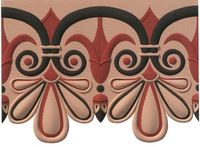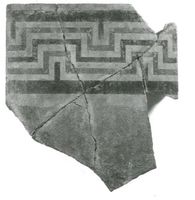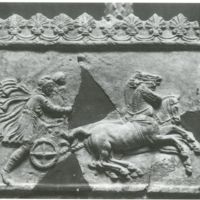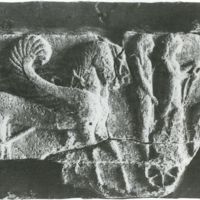Statues and Artwork

3-D reconstruction of revetments from the Temple of Jupiter, John North Hopkins.
In John North Hopkins, The Genesis of Roman Architecture, 103.

Roof tile from the Capitoline Hill, ca. 500.
This tile is from the site of the Capitoline Hill, but not necessarily from the Temple of Jupiter. We have no way of knowing.
In John North Hopkins, The Genesis of Roman Architecture, 103.
The adornments of the Temple of Jupiter Optimus Maximus were made by Vulca, a sculptor from the nearby Veii, one of the neighboring Etruscan peoples.1 On the fastigium (ridge) of the original Temple, there was a sculpted quadriga (four-horse chariot) of painted terracotta.2 Vulca’s terracotta cult statue of Jupiter, inside the central cella, or temple chamber, depicted him standing and brandishing the thunderbolt.3 On feast days the sculpted face of Jupiter was painted with minium, a red pigment. In the statue, Jupiter was shown wearing garments that would later become the attire for Roman generals celebrating a triumph.4 The roof was decorated with terracotta revetments and figures.5 The cornices possibly featured figural friezes, such as those on the left.6 The friezes at left are not from the Temple of Jupiter, but are similar to some scholars' reconstructions of what the Temple adornments might have looked like.
1 Amanda Claridge, Rome: An Oxford Archaeological Guide (Oxford: Oxford University Press, 2010), 268.
2 Filippo Coarelli, Rome and Environs: An Archaeological Guide (Berkeley: University of California Press, 2007), 33-34; L. Richardson, jr., A New Topographical Dictionary of Ancient Rome (Baltimore: the Johns Hopkins University Press, 1992), 222.
3 L. Richardson, jr., A New Topographical Dictionary of Ancient Rome (Baltimore: the Johns Hopkins University Press, 1992), 222.
4 L. Richardson, jr., A New Topographical Dictionary of Ancient Rome (Baltimore: the Johns Hopkins University Press, 1992), 222.
5 L. Richardson, jr., A New Topographical Dictionary of Ancient Rome (Baltimore: the Johns Hopkins University Press, 1992), 222.
6 John W. Stamper, The Architecture of Roman Temples (Cambridge: Cambridge University Press, 2005), 31-32.

